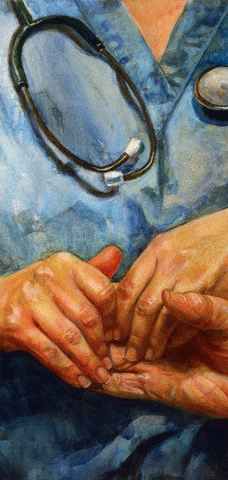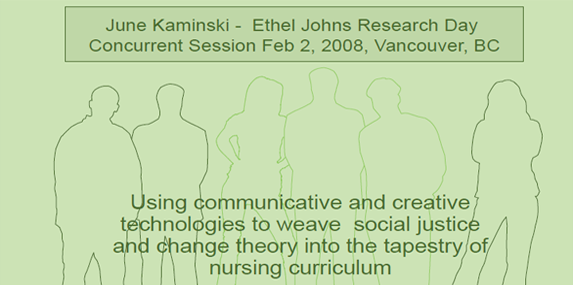Using communicative and creative technologies to weave social justice and change theory into the tapestry of nursing curriculum
by © 2008 ~ June Kaminski, MSN PhD(c)
Presented at Xi Eta Chapter, Sigma Theta Tau International 13th Annual Ethel Johns Forum on February 2nd, 2008.
Also presented at the Second National Nursing Informatics Conference, Toronto, Ontario. Canadian Nursing Informatics Association. October 2nd, 2007.
 Background
Background
This paper presented an analysis of the application of communicative and creative technologies in planning and teaching social justice and activist initiatives in nursing curriculum. The Canadian Nurses Association identified social justice as a priority for nursing practice and education, with a focus on the foundational values of cultural respect, collaboration, equity and capacity building at jurisdictional, national, and international levels (Canadian Nurses Association, 2003). As well, the Code of Ethics that informs nursing in Canada includes a provision related to social justice. "Nurses uphold principles of equity and fairness to assist persons in receiving a share of health services and resources proportionate to their needs and in promoting social justice." (CNA, 2002, p. 8). Furthermore, Canadian nurses are expected to "be aware of broader health concerns such as environmental pollution, violation of human rights, world hunger, homelessness, violence, etc. and are encouraged to the extent possible in their personal circumstances to work individually as citizens or collectively for policies and procedures to bring about social change, keeping in mind the needs of future generations" (p.15).
Dynamics of Distribution
The inclusion of social justice has become a priority for a variety of disciplines, such as education, counseling psychology, social work, and others. Since the early 1990's, the social determinants of health have been promoted as a framework to assess levels of health and well-being on a global scale. These determinants identify income inequality, social inclusion and exclusion, employment and job security, working conditions, contribution of the social economy, early childhood care, education level, food security and housing as key factors that shape health and well-being in individuals, families, and communities (Edwards, 2002). Nursing students learn to view the social determinants of health as foundational to their study of human health and optimal wellness. They are taught to regard these determinants as the root of most health inequalities and that it is their role to work actively to reduce the effects of a lack of social determinant maintenance. Students learn to question how health policy and practice is initiated and to brainstorm ways to influence health reform. As the World Health Organization's Commission on the Social Determinants of Health (CSDH) asked, "What narrative will capture the imaginations, feelings, intellect and will of political decision-makers and the broader public and inspire them to action?" (2005, p. 44).
This question is an important one for nursing educators to ask as well, but in the context of their teaching. Mere regurgitation of social justice and health reform theory is not enough to spark activism in students: instead it often becomes mere rhetoric. To make a real impression, actual praxis is needed. Praxis refers to reflection applied to action, meaningful and intentional activity grounded in theory and knowledge yet expressed through activity and purpose. In general, common means used by various groups to promote social justice activism includes the use of the media and digital action alerts as well as lobbying and coalition building. Since the advent of the world wide web, many media initiatives include an on-line component, often offering information about selected social justice issues, action kits, and methods for interested individuals to join the initiative and easily send letters to appropriate politicians and decision-makers, as well as share the issue with others. Creative technologies such as Macromedia Flash animations, digital video and audio presentations, and web blogs have been developed by some to provide multi-sensory ways to stimulate interest and support in various social justice campaigns. However, very little of this work has been done to date in nursing.
Application to Learning
Since 2005, I have designed and taught a course entitled "Nurses Influencing Change" to fourth year BSN students at Kwantlen University College in British Columbia. The use of information and communication technologies has become a strong thread woven through out this course, with the premise that the 'media' is a powerful force in both preventing and initiating social change. Students are exposed to a plethora of web-based initiatives and tools to both examine and learn how to motivate social justice and change initiatives on a grand scale. They are taught how to apply various change theories, and to organize coalitions, to lobby, and initiate online activist campaigns. The students are required to plan a comprehensive social change project; prepare group presentations about influencing social change; and to create web-based digital media projects in which they need to present a selected social issue and apply a known change theory to create a viable action plan to elicit public support (Kaminski, 2005). The question that has continuously guided this work is, "How can communicative and creative technologies be used to stimulate meaningful social justice and change praxis in nursing curriculum?"
Information and communication technologies were woven into every aspect of this course. Assigned readings were entirely web-based, capitalizing on the vast array of available materials that address common issues pertinent to nursing and social change/justice. All class activities incorporated the media in some way, to make it crystal clear that the use of technologies is an important foundational tool that nurses can use to support social change and justice. For instance, one classroom activity focused on the following:
This use of information and communication technologies to both teach and assess change leadership skills and capabilities and cultivate social justice skills is a first step, but there is much room for further development and planning to afford a supportive, pedagogically sound atmosphere for activist digital design and media application within nursing education. Further work is planned to involve students in focused social activist work, such as the development of EcoNurse © - a comprehensive web environment intended to help nursing students and practitioners to develop keen meaningful ecological knowledge, skills and voice.
References
Canadian Nurses Association. (2002). Code of Ethics for Registered Nurses. Ottawa: Canadian Nurses Association.Canadian Nurses Association. (2003). CNA hosts social justice session. Access. August.
Commission on Social Determinants of Health (2005). Action on the social determinants of health: Learning from previous experiences. Geneva: World Health Organization.
Kaminski, J. (2005). Nurses Influencing Change. Kwantlen Polytechnic University. http://www.nursing-informatics.com/N4111/
Portfolio Menu
As most people are aware, mass media can be used as a vehicle for both social change AND for maintaining the status quo. One of the key distinctions of mass media is that it can affect people's perceptions of social norms. The media play a significant role in forming and influencing people's attitudes and behaviour. Media has a central role in mediating information and forming public opinion. The media casts an eye on events that few people directly experience and renders remote happenings observable and meaningful. It is important that nursing education applies the examination and the creative design of media that can influence the health of Canadians, to prepare nursing students to become active change agents and social justice initiators. The application of information and communication technologies provides a viable and meaningful way to achieve this goal. Further work is needed at a national and provincial level to help educators use technologies to support them to weave social justice and change agent abilities and knowledge into the Canadian nursing curriculum.
















